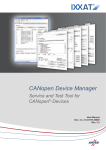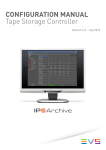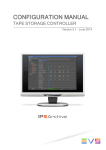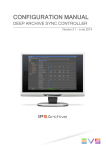Download User Manual - MAD V1.5 Deep Archive Manager V4.0
Transcript
USER MANUAL DEEP ARCHIVE MANAGER Version 1.5 - March 2015 USER MANUAL MAD 1.5 Deep Archive Manager Copyright EVS Broadcast Equipment SA– Copyright © 2003-2015. All rights reserved. Disclaimer The information in this manual is furnished for informational use only and subject to change without notice. While every effort has been made to ensure that the information contained in this user manual is accurate, up-to-date and reliable, EVS Broadcast Equipment cannot be held responsible for inaccuracies or errors that may appear in this publication. Improvement Requests Your comments will help us improve the quality of the user documentation. Do not hesitate to send improvement requests, or report any error or inaccuracy on this user manual by e-mail to [email protected]. Regional Contacts The address and phone number of the EVS headquarters are usually mentioned in the Help > About menu in the user interface. You will find the full list of addresses and phone numbers of local offices either at the end of this user manual (for manuals on hardware products) or at the following page on the EVS website: http://www.evs.com/contacts. User Manuals on EVS Website The latest version of the user manual, if any, and other user manuals on EVS products can be found on the EVS download center, on the following webpage: http://www.evs.com/downloadcenter. I USER MANUAL MAD 1.5 Deep Archive Manager Table of Contents TABLE OF CONTENTS III WHAT'S NEW V 1. ABOUT THE APPLICATION 1 2. INSTALLING THE APPLICATION 2 3. STARTING THE APPLICATION 2 3.1. After Installation 2 3.2. After Configuration 3 3.3. Version and License Check 5 4. 7 USER INTERFACE 4.1. Main Window 4.2. File Data 12 4.3. Archive Queue Tab 13 4.4. Archived Tab 15 4.5. Remove Online Copy Queue Tab 17 4.6. Online Copy Removed Tab 19 4.7. Restore Queue Tab 21 4.8. Restored Tab 23 4.9. Purge Queue Tab 25 4.10. Purged Tab 27 4.11. Search Tab 29 5. SEARCHING FOR FILES 31 5.1. Introduction 31 5.2. How to Search for Files 31 6. SYNCHRONIZING LTO TAPE IDS 35 6.1. Display of Multiple LTO Tapes 35 6.2. Synchronizing the LTO Tape IDs of a Single File 36 6.3. Synchronizing the LTO Tape IDs of All Files 37 7. ERRORS 7.1. Types of Errors Table of Contents 7 38 38 III EVS Broadcast Equipment SA 7.2. Handling Errors From the Deep Archive System 8. MANAGING GRIDS 39 40 8.1. Introduction 40 8.2. Manipulating Columns 40 8.2.1. Adjusting the Width of Columns 40 8.2.2. Reordering Columns 41 8.2.3. Adding and Removing Columns 42 8.2.4. Hiding and Unhiding Columns 43 8.3. Copying Data 44 8.4. Sorting Data 44 8.5. Filtering Data 45 8.5.1. Filtering by Values From a Column 45 8.5.2. Filtering by Criteria 46 8.6. Grouping Data 49 8.7. Performing Basic Calculations on Data 51 8.7.1. Footers and Basic Calculations 51 8.7.2. Performing Basic Calculations on Non-Grouped Data 52 8.7.3. Performing Basic Calculations on Grouped Data 54 8.7.4. Removing Footers 55 8.8. Printing and Exporting Data 9. CONFIGURING THE APPLICATION 56 57 9.1. Settings Window 57 9.2. User Settings 59 9.2.1. Overview User Settings Subcategories 59 9.2.2. Options Tab 59 9.2.3. Language Tab 61 9.3. System Settings IV Issue 1.5.D - March 2015 62 9.3.1. Overview System Settings Subcategories 62 9.3.2. Oracle Connection Tab 63 9.3.3. E-Mail Options Tab 66 Table of Contents USER MANUAL MAD 1.5 Deep Archive Manager What's New In theUser Manual the icon on new and updated features. has been added on the left margin to highlight information The changes linked to new features in version 4.0 are listed below. The application now writes files to the AppData folder instead of it's own executable folder. Added logout function to the File menu. • See section "Main Window" on page "7". Deep Archive Manager now keeps track of multiple LTO tape IDs. • See section "Synchronizing LTO Tape IDs" on page "35". Deep Archive Manager now allows to search for multiple LTO tape IDs. • What's New See section "Searching for Files" on page "31". V USER MANUAL MAD 1.5 Deep Archive Manager 1. About the Application Deep Archive Manageris a user application that forms part of the deep archive module of the central archiving system MediArchive Director or MAD. The deep archive module is responsible for archiving ingested files on LTO tape, for (partially) restoring archived files and for removing files from the storage and from LTO tape. Deep Archive Manager is used to check the status and progress of the archive, restore, remove online copy and purge processes. It also allows to retry failed restore jobs. 1. About the Application 1 EVS Broadcast Equipment SA 2. Issue 1.5.D - March 2015 Installing the Application See the MAD Installation manual for more information on how to install the application. 3. Starting the Application 3.1. After Installation To start the application after installation, proceed as follows: 1. Double-click the Deep Archive Manager icon on the server desktop to start the application. You can also launch the application by double-clicking the executable file (.exe) in the installation folder. The application splash screen appears while the application logs into the MAD database. Then, the Settings window appears allowing you to configure the application. See section "Settings Window" on page "57". 2 2. Installing the Application USER MANUAL MAD 1.5 Deep Archive Manager 3.2. After Configuration To start the application after it has been configured, proceed as follows: 1. Double-click the Deep Archive Manager icon on the server desktop to start the application. You can also launch the application by double-clicking the executable file (.exe) in the installation folder. The application splash screen appears while the application logs into the MAD database. Then, a Login dialog box appears. To be able to log into the application, you need to belong to a user group that has a role which allows to use the application. 2. Enter your username and password and click Login. The main window of the application opens. You get an error notification if: • you have entered a wrong username or password. 3. Starting the Application 3 EVS Broadcast Equipment SA Issue 1.5.D - March 2015 • you have omitted your username. • you have insufficient user rights. • your user account has expired. Warning If you have lost your password, a new password will have to be set in MAD Config. Contact your system administrator. 4 3. Starting the Application USER MANUAL MAD 1.5 Deep Archive Manager 3.3. Version and License Check Introduction The version of the application and the validity of the application license will be checked when the application logs into the MAD database at startup. The status of the version or the license that is returned is displayed on the application splash screen. Version and License Statuses The following version and license statuses can be returned: Status Description Color Action Required Current The actual version of the application. no color No action required. The application starts automatically. Outdated A newer version of the application exists, but this version can still be used. red By default, the application starts automatically after 10 seconds. The application version that should be installed is displayed. Obsolete A newer version of the application exists and must be used. This version may not be used anymore. Click OK to start the application at once. red Click OK to continue. The application shuts down. The application version that should be installed is displayed. Undefined The version of the application is not defined in the MADdatabase. black Click OK to continue. The application shuts down. Beta A test version. blue Click OK to start the application. By default, the application starts automatically after 10 seconds. 3. Starting the Application 5 EVS Broadcast Equipment SA Issue 1.5.D - March 2015 Status Description Color License About to Expire The license period is about to expire. It is shown in how many days the license will expire. orange Click OK to start the application at once. By default, the application starts automatically after 10 seconds. Contact your system administrator or check the License Controller manual. License Expired The license period has expired. The date when the license expired is displayed. Action Required red Click OK to continue. The application shuts down. Contact your system administrator or check the License Controller manual. No Valid License There was no valid license found in the database. red The application shuts down. Contact your system administrator or check the License Controller manual. Maximum Licenses Reached The maximum number of instances <NUMBER OF LICENSES> for the license has been reached. Click OK to continue. red Click OK to continue. The application shuts down. Contact your system administrator or check the License Controller manual. 6 3. Starting the Application USER MANUAL MAD 1.5 Deep Archive Manager 4. User Interface 4.1. Main Window General Description The main window allows you to view all the files that have been requested to be, that are being and that have already been archived, restored, removed from the storage and purged from LTO tape. It enables you to monitor the status and progress of each process and to retry it in case something goes wrong. Illustration The main window contains the areas highlighted on the screenshot below: 4. User Interface 7 EVS Broadcast Equipment SA Issue 1.5.D - March 2015 Area Description The table below describes the various parts of the main window: Part Name Description 1. Menu bar The Menu bar contains four menus: File, Edit, Settings and Help. 2. Tabs The tabs represent a stage in the archive, restore, purge or online copy removal process. They allow to monitor the status and progress of each process. Menu Bar The menu bar contains four menus: File, Edit, Settings and Help. File Menu The File menu contains two commands: Logout and Exit. Click the File menu or use the keyboard shortcut keys ALT + F or F10 + F to open it. Click Exit or use the keyboard shortcut key X to exit the application. Click Logout or use the keyboard shortcut key O to log out of the application. Edit Menu The Edit menu contains one command: Sync All Tape IDs. With the Sync All Tape IDs command you can synchronize the LTO tape IDs of all files that are visible in a particular tab. This command is not available in the Archive Candidates, Refused, Archive Queue, Purge Queue and Purged tab. Settings Menu The Settings menu does not contain any commands. It immediately gives access to the application settings. Click the Settings menu or use the keyboard shortcut keys ALT + S or F10 + S to access the settings. Help Menu The Help menu contains the following commands: Help, Context-Sensitive Help and About. With the Help command you can open the application help file. With the Context-Sensitive Help command you can turn on or off the context-sensitive help mode. In context-sensitive help mode, when you click a user interface item, help for that item is displayed. You can also turn on or off context-sensitive help mode by pressing F1. 8 4. User Interface USER MANUAL MAD 1.5 Deep Archive Manager With the About command the application about box can be opened. The about box displays the application software version, the date until which the application license is valid, the name and version of the database the application is logged on to and the login name used. Click About or use the keyboard shortcut key A to open the application about box. Tabs The main window contains twelve tabs. The table below briefly describes the function of each tab. Tab Description Archive Queue This tab shows a list of files that have been requested to be archived. You can monitor the progress and status of the archive process. See section "Archive Queue Tab" on page "13". Archived This tab shows a list of files that have been archived on LTO tape. It also shows the files that have been fully restored to the storage. You can search for files that have been archived in a particular period. See section "Archived Tab" on page "15". Remove Online Copy Queue Tab This tab shows a list of files that have been requested to be removed from the storage. You can monitor the progress and status of the removal process. See section "Remove Online Copy Queue Tab" on page "17". Online Copy Removed Tab This tab shows a list of files that have been removed from the storage. You can search for files that have been removed from the storage in a particular period. 4. User Interface 9 EVS Broadcast Equipment SA Issue 1.5.D - March 2015 Tab Description Restore Queue Tab This tab shows a list of files that have been requested to be restored to the storage. You can monitor the progress and status of the restore process. See section "Restore Queue Tab" on page "21". Restored Tab This tab shows a list of files that have been fully or partially restored. You can search for the files that have been restored in a particular period. See section "Restored Tab" on page "23". Purge Queue Tab This tab shows a list of files that have been requested to be purged from LTO tape. You can monitor the progress and status of the purge process. See section "Purge Queue Tab" on page "25". Purged Tab This tab shows a list of files that have been purged from LTO tape. You can search for files that have been purged in a particular period. See section "Purged Tab" on page "27". Search Tab This tab allows you to search for files in the database using a number of predefined search criteria. See section "Search Tab" on page "29". Username The username of the person that is currently logged in is displayed next to the application title. Refresh Button The Refresh button allows you to manually refresh the data that is displayed in the various grids. Click the arrow next to the Refresh button to enable or disable the autorefresh functionality. The autorefresh functionality can also be enabled or disabled in the settings and a refresh rate can be specified. 10 4. User Interface USER MANUAL MAD 1.5 Deep Archive Manager See section "Options Tab" on page "59". Counter Each tab has a counter indicating the number of records it contains. It should be noted that the counter does not take into account the filters that may be possibly applied. 4. User Interface 11 EVS Broadcast Equipment SA 4.2. Issue 1.5.D - March 2015 File Data The grids in all the tabs of Deep Archive Manager display the following information about each file: File Data Description Archive ID ID used to archive the file. It consists of the Media ID and the video format ID. Tape Group Name of the LTO tape group. Filename Name of the of the file. Date Requested Date and time the archive, restore or remove online copy request was performed. Each tab also displays additional information that is relevant for that specific tab. 12 4. User Interface USER MANUAL MAD 1.5 Deep Archive Manager 4.3. Archive Queue Tab General Description The Archive Queue tab displays a list of files that have been requested to be archived. Additional File Data The following additional file data is displayed: • Size: The size of the video file. • Date Requested: The date and time the archive request was made. • Status: The current archive status of the file. • Progress: The bar that conveys the progress of the archive task. • Progress Description: The archive progress description originating from the deep archive system. In case an error occurs during the archive process, an error message will be displayed that details what went wrong. Once a file has been archived, it will disappear from the Archive Queue tab and appear in the Archived tab. See section "Archived Tab" on page "15". 4. User Interface 13 EVS Broadcast Equipment SA Issue 1.5.D - March 2015 Archive Status A file can have the following archive statuses: 14 Status Description Unknown The archive status of the file is unknown. Request Archive A request to archive the file has been performed. A deep archive system (HSM) has not been assigned yet. Archive Storage Assigned A deep archive system (HSM) has been found ready to perform the archive request. Archive Requested The request to archive the file has been submitted to the deep archive system (HSM). Archiving The file is being archived by the deep archive system (HSM). Archived The file has been archived. Archive Error An error occurred during the archiving process. 4. User Interface USER MANUAL MAD 1.5 Deep Archive Manager 4.4. Archived Tab Overview The Archived tab displays the files that have been archived to LTO tape. Depending on the settings, it can also displays the files that have been fully restored to the storage. See section "Options Tab" on page "59". Archived Grid By default, the Archived grid displays the files that have been archived or fully restored in the past 7 days. This can be changed in the settings. See section "Options Tab" on page "59". Search Fields A number of search fields are provided which allow you to search for files by: • their archive ID • their name • the date or period in which they were archived or restored By default, the Date Archived/Restored From check box is selected. See section "Searching for Files" on page "31". 4. User Interface 15 EVS Broadcast Equipment SA Issue 1.5.D - March 2015 Additional File Data The following additional file data is displayed: 16 • Size: The size of the video file. • Tapes: The ID of the main and possible backup LTO tape(s) on which the video file has been archived. In order to display the ID of possible backup tapes, a manual synchronization has to be performed. See section "Synchronizing LTO Tape IDs" on page "35". • Date Archived: The date and time the video file was archived. • Date Restored: The date and time the video file was restored. 4. User Interface USER MANUAL MAD 1.5 Deep Archive Manager 4.5. Remove Online Copy Queue Tab General Description The Remove Online Copy Queue tab displays a queue of files that have been requested to be removed from the storage. Additional File Data The following additional file data is displayed: • Size: The size of the video file. • Tapes: The ID of the main and possible backup LTO tape(s) on which the video file has been archived. In order to display the ID of possible backup tapes, a manual synchronization has to be performed. See section "Synchronizing LTO Tape IDs" on page "35". In case something goes wrong during the removal process, an error message will be displayed that details what went wrong. Once a video file has been removed from the storage, it will disappear from the Remove Online Copy Queue tab and appear in the Online Copy Removed tab. See section "Online Copy Removed Tab" on page "19". 4. User Interface 17 EVS Broadcast Equipment SA Issue 1.5.D - March 2015 Remove Online Copy Status A file can have one of the following statuses: 18 Status Description Request Remove Online Copy A request to remove the file from the storage has been performed. Removing Online Copy The high- or low-resolution video file is being removed from the storage. Online Copy Removed The high- or low-resolution video file has been removed from the storage. Remove Online Copy Error An error occurred during the removal of the file. 4. User Interface USER MANUAL MAD 1.5 Deep Archive Manager 4.6. Online Copy Removed Tab Overview The Online Copy Removed tab displays the files that have been removed from the storage. Online Copy Removed Grid By default, the Online Copy Removed grid displays a list of files that have been removed from the storage in the past 7 days. This can be changed in the settings. See section "Options Tab" on page "59". Search Fields A number of search fields are provided which allow you to search for files by: • their Archive ID • their name • the date or period in which they were removed from the storage By default, the Date Removed From check box is selected. See section "Searching for Files" on page "31". 4. User Interface 19 EVS Broadcast Equipment SA Issue 1.5.D - March 2015 Additional File Data The following additional file data is displayed: 20 • Size: The size of the video file. • Tapes: The ID of the main and possible backup LTO tape(s) on which the video file has been archived. In order to display the ID of possible backup tapes, a manual synchronization has to be performed. See section "Synchronizing LTO Tape IDs" on page "35". • Date Removed: The date and time the video file was removed from the storage. 4. User Interface USER MANUAL MAD 1.5 Deep Archive Manager 4.7. Restore Queue Tab General Description The Restore Queue tab displays a queue of files that have been requested to be restored to the storage. Additional File Data The following additional file data is displayed: • Size: The size of the video file. • Tapes: The ID of the main and possible backup LTO tape(s) on which the video file has been archived. In order to display the ID of possible backup tapes, a manual synchronization has to be performed. See section "Synchronizing LTO Tape IDs" on page "35". • Date Requested: The date and time the request to restore the video file was made. • Status: The current restore status of the file. • Progress: The bar that conveys the progress of the restore task. • Progress Description: The restore progress description originating from the deep archive system. In case an error occurs during the restore process, an error message will be displayed that details what went wrong. 4. User Interface 21 EVS Broadcast Equipment SA Issue 1.5.D - March 2015 Retry Button If a restore job goes wrong, a Retry button will appear allowing you to retry the job. See section "Handling Errors From the Deep Archive System" on page "39". Once a video file has been restored, the file will disappear from the Restore Queue tab and appear in the Archived tab. Depending on the settings, it can also appear in the Restored tab. See section "Archived Tab" on page "15" and "Restored Tab" on page 23 and "Options Tab" on page 59. Partially restored files will only appear in the Restored tab. Restore Status A file can have the following restore statuses: 22 Status Description Request Restore A request to restore the video file has been performed. A deep archive system (HSM) has not yet been assigned. Restore Storage Assigned A deep archive system (HSM) has been found ready to perform the restore request. Restore Requested The request to restore the video file has been submitted to the deep archive system (HSM). Restoring The video file is being restored. Restore Error An error occurred during the restore process. Partially Restored The video file has been partially restored from LTO tape. 4. User Interface USER MANUAL MAD 1.5 Deep Archive Manager 4.8. Restored Tab Overview The Restored tab displays the files that have been restored to the storage. The highresolution video files can be fully or partially restored. The low-resolution video files can only be fully restored. Restored Grid By default, the Restored grid displays the files that have been restored in the past 7 days. This can be modified in the settings. See section "Options Tab" on page "59". Search Fields A number of search fields are provided which allow you to search for files by: • their Archive ID • their name • the date or period in which they were restored to the storage. By default, the Date Restored From check box is selected. See section "Searching for Files" on page "31". 4. User Interface 23 EVS Broadcast Equipment SA Issue 1.5.D - March 2015 Additional File Data The following additional file data is displayed: 24 • Partial: A check box that indicates if the record is a partially restored file or not. When checked, it is a partially restored file. When unchecked, it is a fully restored file. • Size: The size of the video file. • Date Restored: The date and time the video file was fully or partially restored. • Tapes: The ID of the main and possible backup LTO tape(s) on which the video file has been archived. In order to display the ID of possible backup tapes, a manual synchronization has to be performed. See section "Synchronizing LTO Tape IDs" on page "35". 4. User Interface USER MANUAL MAD 1.5 Deep Archive Manager 4.9. Purge Queue Tab General Description The Purge Queue tab displays a queue of files that have been requested to be purged from LTO tape. Additional File Data The following additional file data is displayed: • Size: The size of the video file. • Tapes: The ID of the main and possible backup LTO tape(s) from which the video file has to be removed. • Status: The current purge status of the file. In case an error occurs during the purge process, an error message will be displayed that details what went wrong. Note Depending on your user rights, the Purge Queue tab will be visible or not. For more info, contact your system administrator. 4. User Interface 25 EVS Broadcast Equipment SA Issue 1.5.D - March 2015 Purge Status A file can have one of the following purge statuses: 26 Status Description Purge Requested A request to remove the file from LTO tape has been performed. Purging The file is being removed from LTO tape. Purged The file has been removed from LTO tape. Purge Error An error occurred during the purge process. 4. User Interface USER MANUAL MAD 1.5 Deep Archive Manager 4.10. Purged Tab Overview The Purged tab displays the files that have been purged from LTO tape. Purged Grid By default, the Purged grid displays the files that have been purged from LTO in the past 7 days. This can be modified in the settings. See section "Options Tab" on page "59". Search Fields A number of search fields are provided which allow you to search for files by: • their Archive ID • their name • the date or period in which they were purged By default, the Date Purged From check box is selected. See section "Searching for Files" on page "31". Additional File Data The following additional file data is displayed: • 4. User Interface Size: The size of the video file. 27 EVS Broadcast Equipment SA • Issue 1.5.D - March 2015 Date Purged: The date and time the video file was purged from LTO tape. Note Depending on your user rights, the Purged tab will be visible or not. For more info, contact your system administrator. 28 4. User Interface USER MANUAL MAD 1.5 Deep Archive Manager 4.11. Search Tab General Description The Search tab allows you to search for files in the database using a number of search criteria. Search Criteria Files can be searched by: • their Archive ID • their name • the ID of the LTO tape(s) they were archived to • their video format • the date or period their status was last updated in Deep Archive Manager • their archive status. The search criteria can be combined to narrow down the search results. Only the selected criteria are active. To start a search, you have to click the Search button message will appear indicating the number of search results. 4. User Interface . A warning 29 EVS Broadcast Equipment SA Issue 1.5.D - March 2015 The data in the search results grid can be sorted, filtered and grouped. See section "Managing Grids" on page "40". 30 4. User Interface USER MANUAL MAD 1.5 Deep Archive Manager 5. Searching for Files 5.1. Introduction Deep Archive Manager allows you to search for files in two possible ways: 5.2. • You can use the search fields that are provided in the Archive Candidates, Refused, Archived, Online Copy Removed, Restored and Purged tab to search for files with a specific archive status. • You can also make use of the Search tab. This tab allows you to search for all files in the database. See section "Search Tab" on page "29". How to Search for Files Searching by Filename To search for files by their name, proceed as follows: 1. Enter (part of) the filename in the field next to the Filename check box. The check box will be automatically selected. 2. Click the Search button to start the search. Searching by Tape ID To search for files by the ID of the LTO tape(s) they have been archived to, proceed as follows: 1. Enter (part of) the tape ID(s) in the field next to the Tape Id check box. The check box will be automatically selected. Do not forget to add a comma between each tape ID. 2. Click the Search button to start the search. Searching by Date or Period To search for files that have been archived, restored, purged or that have been removed from the storage on a particular day or in a particular period, proceed as follows: 1. Open the desired tab. 2. In the Date From box, do one of the following: ◦ 5. Searching for Files Enter the desired start date. The check box will be automatically selected. Proceed to step 4. 31 EVS Broadcast Equipment SA ◦ Issue 1.5.D - March 2015 Click the downward pointing arrow to open a date picker. Proceed to step 3. If you do not enter a date range, a message will appear warning you that the search may take a long time. Click Yes to continue or No to abort the search. 3. Do one of the following: ◦ Select the desired year, month and day. ◦ Click Clear to clear the currently selected date and select a new date. ◦ Click Today to select the current date. The check box will be automatically selected. 4. In the To box, enter an end date for the period or select a date from the date picker. To display the files that have been archived, restored, purged or that have been removed on a particular day, enter the same date as the one you entered in the Date From box. 5. Click the Search button to start the search. Searching by Update Period To search for files in the database by the date or period their archive status was last updated in Deep Archive Manager, proceed as follows: 1. In the Date Updated From box, do one of the following: 32 ◦ Enter the desired start date. The check box will be automatically selected. Proceed to step 3. ◦ Click the downward pointing arrow to open a date picker. 5. Searching for Files USER MANUAL MAD 1.5 Deep Archive Manager Proceed to step 2. 2. Do one of the following: ◦ Select the desired year, month and day. ◦ Click Clear to clear the currently selected date and select a new date. ◦ Click Today to select the current date. The check box will be automatically selected. 3. In the To box, enter an end date for the period or select a date from the date picker. To display the files whose archive status was last updated on a particular day, enter the same date as the one you entered in the Date Updated From box. 4. Click the Search button to start the search. A warning message appears indicating the number of files found. If there are a lot of results, the loading can take some time. 5. Click Yes to continue or No to cancel the search operation. Searching by Archive Status To search for files in the database by their archive status, proceed as follows: 1. Open the Statuses drop-down list and select the desired archive status from the list. Multiple statuses can be selected. 5. Searching for Files 33 EVS Broadcast Equipment SA Issue 1.5.D - March 2015 The check box will be automatically selected. 2. Click the Search button to start the search. A warning message appears indicating the number of fles found. If there are a lot of results, the loading can take some time. 3. Click Yes to continue or No to cancel the search operation. 34 5. Searching for Files USER MANUAL MAD 1.5 Deep Archive Manager 6. Synchronizing LTO Tape IDs 6.1. Display of Multiple LTO Tapes Introduction Deep Archive Manager allows you at any moment to keep track of the LTO tapes on which a video file is actually archived by displaying their IDs in the Tapes column. In certain cases, these IDs automatically appear in the Tapes column. In other cases, you will have to manually request the retrieval of this information from the hierarchical storage management system. In Case of a Normal Archive Workflow In case of a normal archive workflow, Deep Archive Manager automatically displays the LTO tape ID as soon as the file has been successfully archived. In Case of Backup Tapes In case one or more backup tapes have been created of the LTO tape on which the video file has been archived, the ID of these tapes is not automatically displayed in Deep Archive Manager. You will have to manually request the retrieval of these IDs from the hierarchical storage management system. You can request the retrieval of this information for one specific file, but also for all files visible in the tab. See section "Synchronizing the LTO Tape IDs of a Single File" on page "36" and "Synchronizing the LTO Tape IDs of All Files" on page 37 for more information. If MADinterfaces with DIVA, you can also retrieve this information using the Deep Archive Sync tool. See the user manual for more information. In Case of Tape Repacking In case a video file has been moved to another LTO tape because of a tape repack operation, and IP2Archive does not interface with DIVA, then the ID of the new LTO tape is not automatically displayed in the Deep Archive Manager. You can request the retrieval of this information for one specific file, but also for all files visible in the tab. See section "Synchronizing the LTO Tape IDs of a Single File" on page "36" and "Synchronizing the LTO Tape IDs of All Files" on page 37 for more information. 6. Synchronizing LTO Tape IDs 35 EVS Broadcast Equipment SA Issue 1.5.D - March 2015 If MADinterfaces with DIVA, then in the background, the Deep Archive Sync Controller tool will automatically retrieve this information from DIVA and update it in the MADdatabase after the repack has been successfully updated. You can also manually retrieve this information using the Deep Archive Sync tool. See the user manual for more information. In Case of a Manual Purge In case a video file has been manually purged from the main or a backup LTO tape using the HSM instead of Deep Archive Manager, this is not automatically reflected in the Tapes column. You can request the retrieval of this information for one specific file, but also for all files visible in the tab. See section "Synchronizing the LTO Tape IDs of a Single File" on page "36" and "Synchronizing the LTO Tape IDs of All Files" on page 37 for more information. If MADinterfaces with DIVA, you can also retrieve this information using the Deep Archive Sync tool. See the user manual for more information. 6.2. Synchronizing the LTO Tape IDs of a Single File To synchronize the LTO tape IDs of a single file, proceed as follows: 1. Select and right-click the desired file. 2. From the context menu, select Sync Tape IDs. Note that this option is not available in the following tabs: Archive Candidates, Refused, Archive Queue, Purge Queue and Purged tab. An hourglass icon appears in the Tapes column next to the tape IDs that are already present. In the background, the LTO tape IDs in the MAD database are synchronized with the ones in the database of the hierarchical storage management system. Once the synchronization has been completed, the hourglass icon disappears again. The LTO tape IDs are separated by a comma. 36 6. Synchronizing LTO Tape IDs USER MANUAL MAD 1.5 Deep Archive Manager 6.3. Synchronizing the LTO Tape IDs of All Files To synchronize the LTO tape IDs of all files in a particular tab, proceed as follows: 1. Open the desired tab. 2. From the Edit menu, select Sync All Tape IDs. Note that this option is not available in the following tabs: Archive Candidates, Refused, Archive Queue, Purge Queue and Purged tab. ◦ If the list does not contain any partial restores, an hourglass icon appears in the Tapes column next to the tape IDs that are already present. In the background, the LTO tape IDs in the MADdatabase are synchronized with the ones in the database of the hierarchical storage management system. Once the synchronization has been completed, the hourglass icon disappears again. The LTO tape IDs are separated by a comma. ◦ If the list only contains partially restored files, then an error message appears: 'Partial clips cannot be synced. You need to request the sync of the full clip.' Click OK to close the message. ◦ If the list contains a mix of partial and full restores, the following message appears: 'Partial clips cannot be synced. You need to request the sync of the full clip. You want the sync the tape ID of x records?' Click Yes to perform the synchronization for the fully restored files. 6. Synchronizing LTO Tape IDs 37 EVS Broadcast Equipment SA Issue 1.5.D - March 2015 7. Errors 7.1. Types of Errors Two types of errors can be distinguished in the Archive Queue, Remove Online Copy Queue, Restore Queue and Purge Queue tab of the Deep Archive Manager: • Errors originating from the deep archive system, e.g. archive, remove online copy, restore and purge errors. • Errors not originating from the deep archive system, e.g. database errors. The errors are displayed in the grid below the file they apply to. In the Restore Queue a Retry button appears next to each file with an error message. The error messages can be hidden by selecting the Hide Remarks check box. 38 7. Errors USER MANUAL MAD 1.5 Deep Archive Manager 7.2. Handling Errors From the Deep Archive System Retrying Errors To retry the restoring of a particular file, proceed as follows: 1. Click the Retry button . A dialog box appears. 2. Select: ◦ the first retry method, if you want Deep Archive Manager to automatically return to the status prior to the error status. This retry method is selected by default. ◦ the second retry method, if you want the deep archive system to restart the process. If the error gets solved, the process will continue. Otherwise, the record will go into error again. 7. Errors 39 EVS Broadcast Equipment SA 8. Managing Grids 8.1. Introduction Issue 1.5.D - March 2015 In Deep Archive Manager most of the data is displayed in grids. Each grid consists of a number of columns containing specific information. Deep Archive Manager provides you a number of features to customize each grid. You can: • adjust the width of each column • reorder columns • add and remove columns • hide and unhide columns • sort, filter and group data • perform basic calculations on data. You can also print the data of each grid or export it to Excel for reporting purposes. Note • Sorting data is not possible in the Archive Queue, Remove Online Copy Queue, Restore Queue and Purge Queue tab. • Grouping data is only possible in the Search tab. 8.2. Manipulating Columns 8.2.1. Adjusting the Width of Columns The width of each grid column can be manually or automatically adjusted. How to Manually Adjust the Column Width To manually adjust the width of a particular column, drag the right or left border of the column header until the column has the desired width. To manually change the width of a column to fit its contents, double-click the boundary on the right side of the column header. If you hold your cursor over a column header border, it will change into a double-headed arrow. How to Automatically Adjust the Column Width 40 8. Managing Grids USER MANUAL MAD 1.5 Deep Archive Manager To automatically adjust the width of a column to fit its contents, right-click the column header, and then select the Best Fit option from the context menu. To automatically adjust the width of all columns to fit their contents, right-click the column header, and then select the Best Fit (all columns) option from the context menu. 8.2.2. Reordering Columns If you want the information in a grid to be displayed in a different order, you can change the position of the columns. There are two ways to reorder columns. How to Reorder a Column Using a Drag-And-Drop Action To reorder a column by directly dragging its header, proceed as follows: 1. Click the header of the column you want to move and hold down your left mouse button. 2. Drag the column header to the desired position in the grid. Two arrows will indicate where it is possible to insert the column. A black prohibition sign will indicate where the column cannot be inserted. 3. Release the left mouse button to insert the column. How to Reorder a Column Using the Show/Hide/Move Button You can also reorder the columns of a grid by using the Show/Hide/Move button: 1. Click on the left side of the first column header. A drop-down list containing the headers of the grid columns appears. The column headers are listed in the order in which the columns are displayed in the grid. The first header in the list is the leftmost field in the grid. The columns that are visible in the grid are selected. The headers in the screenshot below can differ from the headers available in your application. 8. Managing Grids 41 EVS Broadcast Equipment SA Issue 1.5.D - March 2015 2. Select a header and drag it to the desired position in the list. Green arrows will appear indicating where you can insert the grid. In the grid, the column will be moved to the new position. 8.2.3. Adding and Removing Columns If you want more or less information to be displayed in a particular grid, you can simply add or remove one or more columns. How to Add a Column To add a column to a grid, proceed as follows: 1. Right-click the header of a column, and then select the option Field Chooser from the context menu. A dialog box appears with a list of predefined columns you can add to the grid. Note that the column headers shown in the screenshot below can differ from the ones displayed in your application. 2. From the list, select the header of the column you want to add to the grid. 3. Drag the column header to the desired position in the grid. 42 8. Managing Grids USER MANUAL MAD 1.5 Deep Archive Manager Two green arrows will appear indicating where you can insert the column. A black prohibition sign or cross will appear if you try to insert the column in a location where it cannot be inserted. 4. Release the left mouse button to insert the column. How to Remove a Column To remove a column from a grid, right-click its header and then select the option Remove This Column from the context menu. The column will disappear from the grid and its header will be added to the dialog box containing the columns that can be added to the grid. The removed column can be added again to the grid. 8.2.4. Hiding and Unhiding Columns You can temporarily hide columns from a grid without having to remove them. Afterwards, you can easily make them visible again. How to Hide a Column To hide a particular column from a grid, proceed as follows: 1. Click the Show/Hide/Move button in the top left corner of the grid. A drop-down list will appear with the available columns. 2. Deselect the check box next to the header of the column you want to hide from the grid. How to Unhide a Column To make a hidden column visible again, proceed as follows: 8. Managing Grids 43 EVS Broadcast Equipment SA Issue 1.5.D - March 2015 1. Click the Show/Hide/Move button in the top left corner of the grid. A drop-down list will appear with the available columns. 2. Select the check box next to the header of the column you want to make visible again. 8.3. Copying Data To copy the data of a particular grid row to the Clipboard, proceed as follows: 1. Select the appropriate row in the grid. 2. Press CTRL +C. 8.4. Sorting Data Each grid can be sorted according to the values in one of the columns. You can sort text (from A-Z or from Z-A), numbers (from low to high or from high to low). How to Sort Data by Clicking a Column Header To sort the data in a particular column, click the column header once to sort the data in ascending order. Click again to sort the data in descending order. An arrow next to the column header indicates the sorting method. sorted in ascending order sorted in descending order How to Sort Data by Using the Context Menu You can also sort the data in a particular column by right-clicking the column header and selecting the desired sorting method from the context menu. To clear the sorting in a particular column, right-click the column header and select the option Clear Sorting from the context menu. 44 8. Managing Grids USER MANUAL MAD 1.5 Deep Archive Manager 8.5. Filtering Data You can filter the data in a grid by using two types of filters: by one or more values from a particular column or by simple or complex criteria. 8.5.1. Filtering by Values From a Column To filter the data in a particular grid by one or more values from a particular column, proceed as follows: 1. Hold your cursor over the header of the column by whose values you want to filter the grid, and then click the filter button. A drop-down list opens containing all the column values. 2. Select the desired values. Only the records that contain one of the selected values are displayed in the grid. At the bottom of the grid a filter bar appears displaying the applied filter. 3. In the filter bar, do one of the following: 8. Managing Grids ◦ Clear the check box next to the filter the filter again. to undo it. Select the check box to apply ◦ Click to undo the filter and close the filter bar. ◦ Click to open a drop-down list containing previously applied filters. ◦ Click Customize to create a complex filter. 45 EVS Broadcast Equipment SA 8.5.2. Issue 1.5.D - March 2015 Filtering by Criteria Filters by criteria can be simple or complex: • Simple filters consist of one or two criteria and one Boolean operator (AND or OR). • Complex filters consist of more than two criteria and more than one Boolean operator (AND, OR, NOT AND and NOT OR). How to Create a Simple Filter To create a simple filter, proceed as follows: 1. Hold your cursor over the header of the desired column, and then click the filter button appearing in the right corner. 2. From the drop-down list, select the option (Custom…). The Custom Filter dialog box appears. Here you can enter the criterion or the two criteria you want to filter the values of the selected column by. 3. Select the desired comparison operator from the first drop-down list. A comparison operator is used in comparison criteria to compare two values. Operators include: ‘equals’, ‘does not equal’, ‘is less than’, ‘is less than or equal to’, ‘is greater than’, ‘is greater than or equal to’, ‘like’, ‘not like’, ‘is blank’ and ‘is not blank’. For example, if you want to filter the values of a column by text that includes a certain word, character or sign, you have to select the comparison operator ‘like’. 4. Enter text in the field next to the first drop-down list. For example, if you want to filter by text that includes the letter ‘S’, type %S%. The % wildcard can substitute for zero or more characters. The _ character can substitute for exactly one character. 46 8. Managing Grids USER MANUAL MAD 1.5 Deep Archive Manager 5. If you want to add a second filter criterion, select the desired Boolean operator. Select: ◦ AND, if both criteria have to be true; ◦ OR, if at least one of the criteria or both have to be true. 6. Select the desired comparison operator from the second drop-down list, and then enter text in the field at the right. 7. Click OK to apply the filter. Only the values matching the entered criterion or criteria will be displayed. How to Create a Complex Filter To create a complex filter, proceed as follows: 1. Apply a simple filter to a grid or filter a grid by selecting one or more values from a list of values. See above. At the bottom of the grid a filter bar appears. 2. In the filter bar, click the Customize button. A dialog box appears that allows you to create complex filters. The criteria of the active filter are displayed in a tree structure. Here you can add extra criteria and change the existing criteria. 3. Do one of the following: • • 8. Managing Grids To add a new criterion, do one of the following: ◦ click the Press the Button to Add a New Condition button; ◦ click the Filter button and select Add Condition; ◦ click next to a criterion and select Add Condition. To change a criterion, do one of the following: ◦ click a column header (green and underlined text) and select another value from the list; ◦ click a comparison operator (dark red and underlined text) and select another value from the list: ‘equals’, ‘does not equal’, ‘is less than’, ‘is less than or equal to’, ‘is greater than’, ‘is greater than or equal to’, ‘like’, ‘not like’, ‘is blank’, ‘is not blank’, ‘between’, ‘not between’, ‘in’, ‘not in’; 47 EVS Broadcast Equipment SA ◦ Issue 1.5.D - March 2015 click the dark blue text on the right of the comparison operator and enter another value. • To delete a criterion, click the Remove Row. • To add a group of criteria, do one of the following: • button to the left of the criterion and select the option ◦ click next to a random criterion and select Add Group; ◦ click the Filter button and select Add Group. To delete all criteria, click the Filter button and select the option Clear All. 4. Do one of the following: ◦ To open an existing complex filter, click Open; ◦ To save the current filter, click Save As; ◦ To confirm the changes and close the dialog box, click OK; ◦ To undo the changes, click Cancel. ◦ To apply the changes, click Apply. At the bottom of the grid a bar appears which displays the components of the complex filter. Note that if you have already created a custom filter in the past, you can reapply it by clicking the current filter or the downward pointing arrow. A drop-down list containing previous filters appears. 48 8. Managing Grids USER MANUAL MAD 1.5 Deep Archive Manager 8.6. Grouping Data The data in each grid can be grouped by one or more columns. How to Group Data To group the data in a grid by one or more columns, proceed as follows: 1. Right-click any column header. 2. From the context menu, select the option: ◦ Group By This Field if you want to quickly group the data in the grid by this column. The Group By box automatically appears above the grid displaying the header of the column(s) the data is grouped by. By default, the groups are sorted in ascending order. To change the sorting of the groups, click the column header in the Group By box. Proceed to step 4. ◦ Group By Box if you want to group the data by dragging one or more column headers to the Group By box. The Group By box appears above the grid. Proceed to step 3. 3. Drag the header of the column by which you want to group the data in the grid to the Group By box. Two green arrows will indicate where you can drop the column header. 8. Managing Grids 49 EVS Broadcast Equipment SA Issue 1.5.D - March 2015 4. (Optional) To create subgroups, drag one or more of the other column headers to the Group By box. Two green arrows will indicate where you can insert the header. You can add each new header before or after the headers that are already there. If necessary, you can still reorder the headers to change the grouping hierarchy. How to Ungroup Data To undo a grouping, do one of the following: • Drag the desired column header from the Group By box back to the grid. • Right-click the header of the column in the Group By box you want to remove from the grouping and select the option Remove From Grouping from the context menu. This option only appears if a grouping has been applied. To remove the Group By box again, right-click any column header in the grid and select the option Group By Box from the context menu. 50 8. Managing Grids USER MANUAL MAD 1.5 Deep Archive Manager 8.7. Performing Basic Calculations on Data 8.7.1. Footers and Basic Calculations You can perform basic calculations on the data in a grid by adding footers. Types of Footers Two types of footers can be distinguished: • Grid footer: Footer added at the bottom of a grid allowing you to perform calculations on all values in a particular column. • Group footer: Footer added at the bottom of a group allowing you to perform calculations on the values of a particular column in that group. The result of a calculation performed on the data of a particular column is displayed in a footer cell below the column in the grid or group footer. Basic Calculations Right-clicking a footer cell in a grid or group footer will open the footer context menu. This menu will allow you to select or change the type of calculation that should be performed on the data of a particular column. Depending on the type of data contained in each column, you will be able to perform one or more of the following calculations: 8. Managing Grids • Sum: Adds up all numbers in a column. • Min: Defines the lowest value in a column. • Max: Defines the highest value in a column. • Count: Counts the elements in a column. • Average: Calculates the average value of all numbers in a column. 51 EVS Broadcast Equipment SA 8.7.2. Issue 1.5.D - March 2015 Performing Basic Calculations on NonGrouped Data To perform basic calculations on all the data of one or more column, proceed as follows: 1. Right-click the desired column header. 2. From the context menu, select the Footer option. The grid footer automatically appears at the bottom of the grid. 3. In the grid footer, right-click the footer cell below the column whose data you want to perform calculations on. A context menu with basic calculations appears. Note Depending of the type of data in a column (dates, alphanumeric data), all or only some of the calculations will be available. 4. Select the desired calculation. 52 8. Managing Grids USER MANUAL MAD 1.5 Deep Archive Manager In the footer cell the result of the calculation appears. 8. Managing Grids 53 EVS Broadcast Equipment SA 8.7.3. Issue 1.5.D - March 2015 Performing Basic Calculations on Grouped Data To perform basic calculations on data in a group, proceed as follows: 1. Right-click the header of any column in the grid. 2. From the context menu, select the Group Footers option. This option only becomes available when the data in the grid has been grouped. A group footer is added to each group in the grid. 3. In the group footer, right-click the footer cell below the column whose data you want to perform calculations on. A context menu with basic calculations appears. Note Depending of the type of data in a column (dates, alphanumeric data), all or only some of the calculations will be available. 4. Select the desired calculation. 54 8. Managing Grids USER MANUAL MAD 1.5 Deep Archive Manager In the footer cell the result of the calculation appears. 8.7.4. Removing Footers You can remove the grid and group footers and also clear the content of a cell footer. Do one of the following: 8. Managing Grids • To remove the grid footer or all group footers, right-click any column header and in the context menu deselect the option Footers or Group Footers. • To clear the contents of a cell footer, right-click it and from the footer context menu select the option None. 55 EVS Broadcast Equipment SA 8.8. Issue 1.5.D - March 2015 Printing and Exporting Data The data in a grid can be printed and exported to Excel for reporting purposes. How to Print Data To print the data of a particular grid, proceed as follows: 1. Click the Print button above the grid whose data you want to print. A Print dialog box appears. 2. Click Print to print the grid data. How to Export Data to Excel To export the data of a particular grid to Excel, proceed as follows: 1. Click the Excel Export button Excel. above the grid whose data you want to export to An Excel file is generated. 2. Browse for the folder where you want to save the Excel file. 3. Enter a name in the File Name field or use the default name, and then click Save to save the file. If the folder contains an Excel file with the same file name, a warning message will appear asking you if you want to replace the existing file. Click Yes to continue and No to cancel the operation. Once you have saved the file, a message box appears asking you if you want to open the newly generated Excel file. Click Yes to open the file and No to cancel the operation. 56 8. Managing Grids USER MANUAL MAD 1.5 Deep Archive Manager 9. Configuring the Application 9.1. Settings Window Opening the Settings Window The Settings window allows you to configure your application. The first time the application is launched after it has been installed, the Settings window opens automatically. The Settings window can also be accessed through the Settings menu. Overview Setup Categories The settings can be divided into two setup categories. In the Settings window, a tab is provided for each setup category. The table below briefly describes each setup category: Setup Category Description User Settings These settings can be configured by each individual user. System Settings These settings configure the general functioning of the application. They can only be configured by the system administrator. 9. Configuring the Application 57 EVS Broadcast Equipment SA Issue 1.5.D - March 2015 Edit Mode To be able to edit the System settings, you first have to enter a password. To put the Settings window into Edit Mode, proceed as follows: 1. Click the Enter Into Edit Mode button . A dialog box appears. 2. Enter the administrator password and then click OK. The Settings window enters into Edit Mode. Note Certain settings are read-only and cannot be configured. These can only be modified in the MAD Config application. Other settings have to be configured locally. Saving Settings A Save button is provided which allows you to immediately save the changes you have made to the settings. With the Cancel button you can discard the changes you have made. 58 9. Configuring the Application USER MANUAL MAD 1.5 Deep Archive Manager 9.2. User Settings 9.2.1. Overview User Settings Subcategories The User settings are divided into the following subcategories: • Options • Language For each subcategory a tab is provided. 9.2.2. Options Tab The Options tab contains various settings. Enabling Autorefresh In the Auto Refresh group box the autorefresh functionality can be enabled or disabled and a refresh interval can be defined. By default, the grids are automatically refreshed every 10 seconds. Activating the Filter Bar In the Filters group box you can activate or deactivate the display of the filter bar at the bottom of each grid, enabling you to load previously saved filters without having to select a filter first. 9. Configuring the Application 59 EVS Broadcast Equipment SA Issue 1.5.D - March 2015 Specifying the Storage Folder for Excel Exports The Export group box allows you to specify a storage folder for the Excel exports. By default, the installation folder of the application is selected. Hiding or Showing Restored Files in the Archived Tab The option Show Restored Clips in 'Archived' Tab allows you to hide or show restored files in the Archived tab. If selected, the files will be displayed. If not, the files will be hidden. The files will still be visible in the Restored tab. Defining a Default Search Period In the Search group box you can define the default date range of the date filters in the following tabs: Refused, Archived, Online Copy Removed, Purged and Restored tab. By default, the date range is set to the last 7 days. 60 9. Configuring the Application USER MANUAL MAD 1.5 Deep Archive Manager 9.2.3. Language Tab The Language tab allows you to change the language of the Deep Archive Manager user interface. The default language is set in the Configurator application, but can be changed locally. The language can be set per user. 9. Configuring the Application 61 EVS Broadcast Equipment SA Issue 1.5.D - March 2015 9.3. System Settings 9.3.1. Overview System Settings Subcategories The System settings are divided into the following subcategories: • Oracle Connection • E-Mail Options • IPDirector API For each subcategory a tab is provided. 62 9. Configuring the Application USER MANUAL MAD 1.5 Deep Archive Manager 9.3.2. Oracle Connection Tab The Oracle Connection tab allows you to configure the connection with the Oracle database. Entering the Database Name In this field you have to enter the name of the database the application has to connect to. If the Use This Database Name check box is selected, the name of the database will automatically appear in the Oracle login dialog box at start-up. Note that the database name will be automatically entered and the Use This Database Name check box will be automatically selected when you log into the application for the very first time. Entering the Login Name In this field you have to enter a login name. If the Use This Login Name check box is selected, the login name will automatically appear in the Oracle login dialog box at startup. Note that the login name will be automatically entered and the Use This Login Name check box will be automatically selected when you log into the application for the very first time. 9. Configuring the Application 63 EVS Broadcast Equipment SA Issue 1.5.D - March 2015 Entering a Password In this field you have to enter a password. If the Use Auto Login check box is selected, the application automatically logs into the selected database at start-up. The Oracle login dialog box does not appear. Note that the password will be automatically entered and the Use Login check box will be automatically selected when you log into the application for the very first time. Checking Application History By clicking the Application History button, you can open a chronological list of all software versions of the application. To get more details about each version (creation date, name of programmer, status, additional remarks), you have to click + next to the version number. Activating Keep Alive If the option Keep Connection Alive is selected, a message is sent to the database at regular time intervals to avoid idle connections from being closed by the firewall. These intervals can be set by you. Note that this option will be automatically selected when you log into the application for the very first time. If the option Try to Reconnect if Keep Alive Fails is selected, the application will try a number of times to reconnect with the database. If the option Report Status in Database Everytime Keep Alive Timer Triggers is selected, the status of the connection is reported in the database each time the Keep Alive Timer sends a trigger to send a Keep Connection Alive message. Testing the Oracle Connection The Test Oracle button allows you to check the validity of the database name, login and username you entered. If these data are valid, then the following message appears next to the Test Oracle button: ‘OK’. If the login name or password is invalid, then a message box appears with the following message: ‘ORA-01017: invalid username/password; logon denied’. If the database name is invalid, then a message box appears with the following message: ‘ORA-12154:TNS: could not resolve the connect identifier specified’. If you omit the password, then a message box appears with the following message: ‘ORA-01005: null password given; logon denied’. If you do not enter a database name, login and username, then a message box appears with the following message: ‘ORA-12560: TNS: protocol adapter error’. 64 9. Configuring the Application USER MANUAL MAD 1.5 Deep Archive Manager You can also check the software version of the application by clicking the Test Oracle button. If the software version is up-to-date, then the following message appears: ‘Current– The Current Version’. If the software version is outdated, then the following message appears: ‘Unknown Version Application! Please contact the EDP department.’ If you close the Settings window without testing the validity of the database name, login and username you just entered, then a message box appears. If you click Yes, then the Settings window is closed and the original values are restored. If you click Cancel, then the Settings window does not close and you can test the values by clicking the Test Oracle button. If you change the current database settings, test the connection and then close the Settings window, a message box will appear. If you click Yes, the application is stopped and closed. A manual restart will be required. Click Cancel to continue. 9. Configuring the Application 65 EVS Broadcast Equipment SA 9.3.3. Issue 1.5.D - March 2015 E-Mail Options Tab In case the application is capable of sending e-mail messages, the E-Mail Options tab will allow you to configure an e-mail account, enter the e-mail address of the default sender and recipients, and enter a default e-mail subject. If the application is not capable of sending e-mail messages, the settings in this tab cannot be used. To be able to configure the e-mail account, you have to select the Send E-Mail check box. The fields in the Mail System Settings and Mail Message Settings group box become available. Configuring an E-Mail Account In the Mail System Settings group box you have to enter the IP address and port number of the SMTP server and specify a timeout. In the SMTP Login group box you can enter a user name and password. Configuring a Default E-Mail Message The Mail Message Settings group box contains two tabs: Internal Mail Settings and External Mail Settings. The Internal Mail Settings tab can be used to configure a default e-mail message that will be sent to the EVS developers and the customer when an error occurs. 66 9. Configuring the Application USER MANUAL MAD 1.5 Deep Archive Manager The External Mail Settings tab can be used to configure a default e-mail message that will be sent to the customer to notify him about an error. In each tab you have to enter the sender’s email address, the email address of the various recipients and a subject. It should be noted that this tab is not always used. When you insert multiple e-mail addresses in any of the header fields, make sure you separate them by a comma. To test the settings and manually send an e-mail message, click the Send Mail button. For the new settings to take effect, close and restart the application. Check the TOM.ini file in the AppData\Roaming\EVS Broadcast Equipment\MAD\[Application] folder for the e-mail addresses and subject entered here. 9. Configuring the Application 67 Corporate +32 4 361 7000 North & Latin America +1 973 575 7811 EVS Headquarters Liège Science Park 16, rue Bois St Jean B-4102 Seraing Belgium To learn more about EVS go to www.evs.com Asia & Pacific +852 2914 2501 Other regional offices www.evs.com/contact EVS Broadcast Equipment is continuously adapting and improving its products in accordance with the ever changing requirements of the Broadcast Industry. The data contained herein is therefore subject to change without prior notice. Companies and product names are trademarks or registered trademarks of their respective companies.




























































































